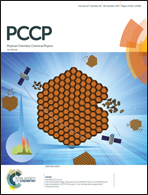Topology vs. thermodynamics in chemical reactions: the instability of PH5†
Abstract
The topological approach, based on Bader theory, is compared to the common thermodynamical methodology to study chemical reactivity. It is shown how the former indeed has numerous advantages and provides a more detailed description with respect to the latter about the course of the reaction. The comparison between the two approaches is performed by considering a classical reaction, i.e. the decomposition of PX5 (X = H, F). The topological investigation was supported by using different state-of-the-art topological tools, such as the source function, Espinosa indexes, delocalisation indexes, and domain-averaged Fermi hole analysis. Furthermore, in this work a new topological descriptor, the Bader energy density, PBADER, is introduced and applied to the study case. For the first time since Bader theory was introduced, the distribution of atomic energies in the atomic basins was analysed in detail and used to explain the chemical reactivity a priori.



 Please wait while we load your content...
Please wait while we load your content...